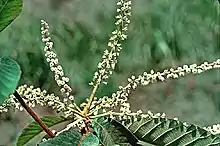| Clethra scabra | |
|---|---|
 | |
| Racemose inflorescence | |
| Scientific classification | |
| Kingdom: | Plantae |
| Clade: | Tracheophytes |
| Clade: | Angiosperms |
| Clade: | Eudicots |
| Clade: | Asterids |
| Order: | Ericales |
| Family: | Clethraceae |
| Genus: | Clethra |
| Species: | C. scabra |
| Binomial name | |
| Clethra scabra | |
| Synonyms[1] | |
| |
Clethra scabra is a shrub or tree growing in habitats from 950 to 2,500 m (3,120 to 8,200 ft) in altitude, native to the eastern Andes and adjacent montane woodlands and Chaco of Brazil, Bolivia, Paraguay, and northwest Argentina. It is able to reach 25 m (82 ft) in height, and is known to flower during March. It bears simple ovate to elongate and slightly obovate leaves 8 to 10 cm (3.1 to 3.9 in) in length and 4 to 6 cm (1.6 to 2.4 in) in width. These leaves tend to bear stellate hairs, and have prominent veins upon their abaxial face. The white flowers are small, borne upon a terminal spray of racemes.[2]
References
- ↑ "Clethra scabra Pers". Plants of the World Online. Royal Botanic Gardens, Kew. Retrieved 2020-07-20.
- ↑ Killeen, T. J.; García E., E. & Beck, S. G. 1993. Guía de Arboles de Bolivia. Herbario Nacional de Bolivia & Missouri Botanical Garden, La Paz. 214.
This article is issued from Wikipedia. The text is licensed under Creative Commons - Attribution - Sharealike. Additional terms may apply for the media files.